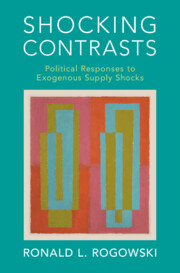Book contents
- Shocking Contrasts
- Political Economy of Institutions and Decisions
- Shocking Contrasts
- Copyright page
- Dedication
- Epigraph
- Contents
- Figures
- Maps
- Tables
- Preface and Acknowledgments
- Introduction
- 1 How Supply Shocks Arise and Why Political Responses to Them Vary
- 2 Who Adjusts to a Supply Shock and Who Resists It
- 3 Why a Technological Solution Does, or Does Not, Emerge
- 4 Exogenous Loss of Labor
- 5 Exogenous Gain of Labor: Railroads, Reproduction, and Revolution
- 6 Exogenous Loss of Land
- 7 Exogenous Increase of Human Capital
- 8 When the Endogenous Becomes Exogenous
- 9 Conclusion
- References
- Index
- Other books in the series (continued from page iii)
3 - Why a Technological Solution Does, or Does Not, Emerge
Published online by Cambridge University Press: 09 June 2023
- Shocking Contrasts
- Political Economy of Institutions and Decisions
- Shocking Contrasts
- Copyright page
- Dedication
- Epigraph
- Contents
- Figures
- Maps
- Tables
- Preface and Acknowledgments
- Introduction
- 1 How Supply Shocks Arise and Why Political Responses to Them Vary
- 2 Who Adjusts to a Supply Shock and Who Resists It
- 3 Why a Technological Solution Does, or Does Not, Emerge
- 4 Exogenous Loss of Labor
- 5 Exogenous Gain of Labor: Railroads, Reproduction, and Revolution
- 6 Exogenous Loss of Land
- 7 Exogenous Increase of Human Capital
- 8 When the Endogenous Becomes Exogenous
- 9 Conclusion
- References
- Index
- Other books in the series (continued from page iii)
Summary
Technological solutions to sudden factor shortages are difficult and costly, hence unlikely to be sought if such easier solutions as factor substitution or factor mobility are available. When the demand does arise, a technological innovation is likelier: (a) the more intense the demand; (b) the less daunting the leap from existing technologies; and (c) the larger the pool of potential innovators. The size of that pool is restricted by language barriers but expanded by vehicles that transmit new ideas. Governments can do little to stimulate creation of a new technology but can adopt or reject the institutional changes that the new technology requires. Military technology is often seen as causative of political change, but the supporting evidence is weak. New techniques of warfare more often arise in response to changed availability of factors. A positive supply shock renders all other factors newly scarce. Thus the “China shock” of increased availability of low-skill labor has created incentives in advanced economies to develop technologies that economize on scarce human and physical capital.
Keywords
- Type
- Chapter
- Information
- Shocking ContrastsPolitical Responses to Exogenous Supply Shocks, pp. 37 - 54Publisher: Cambridge University PressPrint publication year: 2023



